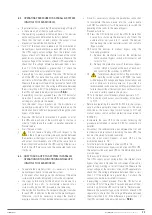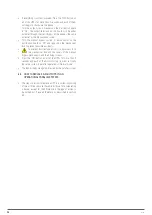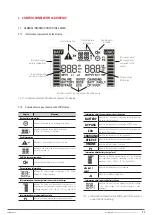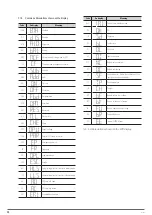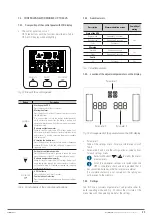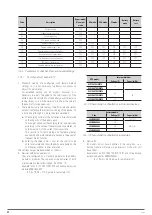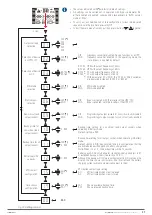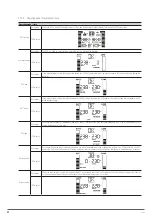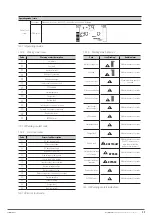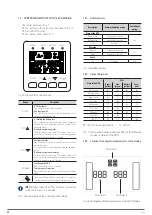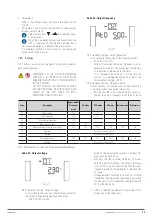
20
SALICRU
Model
Rated voltage
of batteries
Minimum values,
fast type fuses
DC voltage (V)
Current (A)
SLC-700-TWIN RT2
(12 V x 3) = 36 V
125
20
SLC-1000-TWIN RT2
32
SLC-1500-TWIN RT2
50
SLC-2000-TWIN RT2
(12 V x 4) = 48 V
SLC-3000-TWIN RT2
(12 V x 6) = 72 V
SLC-4000-TWIN RT2
(12 V x 16) = 192V
400
20
SLC-5000-TWIN RT2
32
SLC-6000-TWIN RT2
SLC-8000-TWIN RT2
40
SLC-10000-TWIN RT2
50
Tab. 2.
Protection features between device and battery
module.
•
Before starting the connection process between
battery module or modules and device, check that
the device and loads are ‘Off’.
Also, when the batteries are installed by the user
independently, the protection fuse or isolator must be
deactivated.
•
Connection of the battery module to the device is made by
means of a cable featuring polarised connectors at both
ends, which is supplied with the first one. Two connectors
are available for this purpose on the device and battery
module.
Similarly, the battery modules feature two connectors that
allow the linking of modules in parallel.
•
Each battery module is independent for each device.
Two devices must not be connected to the
same battery module
.
Likewise, in parallel systems (4 to 10 kVA models), with
each device connected to its battery module or modules,
they should be considered as single devices that are
independent of each other.
•
Fig. 13 shows the connection of a 10 kVA device in a
rack arrangement with two battery modules. For a larger
number, proceed in a manner similar to those shown in the
illustration.
Fig. 13.
Connection to battery modules.
5.2.4. Connection of the input earth terminal
(
)
and the
earth connection terminal
(
)
.
•
As the device has Class I protection against electric
shock, it is essential to install a protective earth
conductor (connect earth (
)). Connect this conductor
before supplying voltage to the input terminals.
•
Make sure that all of the loads connected to the UPS are only
connected to its earth connection terminal (
). Failure to
limit the earthing of the load or loads and battery module or
modules to this
single point
will create earth return loops
that will degrade the quality of the power supplied.
•
All terminals identified as an earth connection (
) are
connected to each other, to the earth terminal (
) and to
the device’s earth.
5.2.5. Terminals for EPO (emergency power off).
•
The UPSs have two terminals for the installation of an
external emergency power off (EPO) output button.
•
The device is dispatched from the factory with its EPO
circuit set to closed (NC) by default. In other words, the
UPS will cut the output power supply, emergency power
off, when the circuit is opened:
Either by removing the female connector from the socket
where it is inserted. This connector has a cable connected
as a jumper that closes the circuit (see Fig. 14-A).
Or by pressing the button external to the device
belonging to the user installed between the terminals
of the connector (see Fig. 14-B). The connection on the
button must be in the normally closed contact (NC), so
it will open the circuit when activated.
The reverse functionality can be selected through the
communications software and control panel.
Except for specific cases, we advise against this type
of connection in view of the purpose of the EPO button,
since it will not act upon an emergency request if either
of the two cables that run from the button to the UPS is
accidentally cut.
By contrast, this anomaly would immediately be detected
in a closed EPO circuit, with the inconvenience of an
unexpected cut in the powering of the loads, but a
guarantee of effective emergency functionality.
•
To recover the normal operating state of the UPS, it is
necessary to insert the connector with the jumper in its
receptacle or deactivate the EPO button. The device will
be operational.
A
B
Fig. 14.
Connector for external EPO.




















